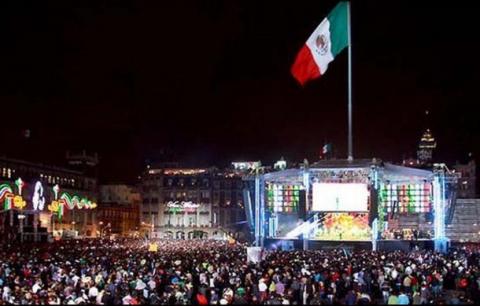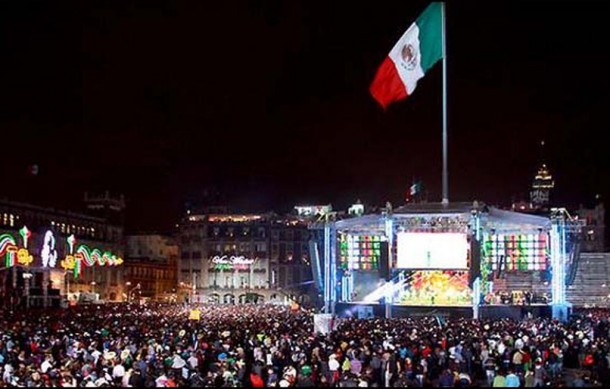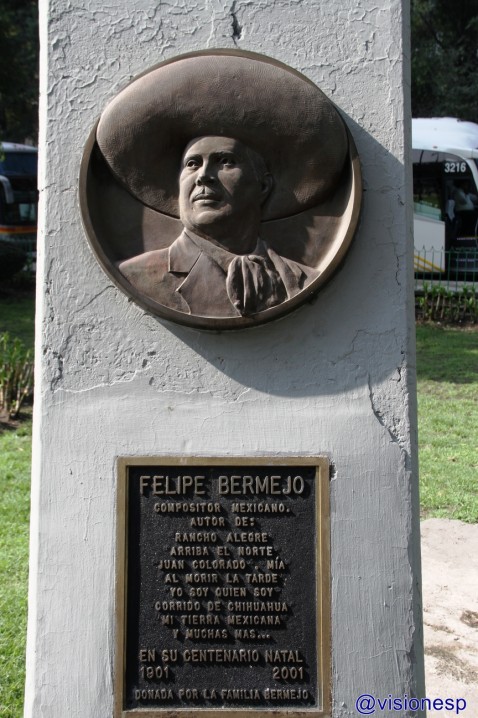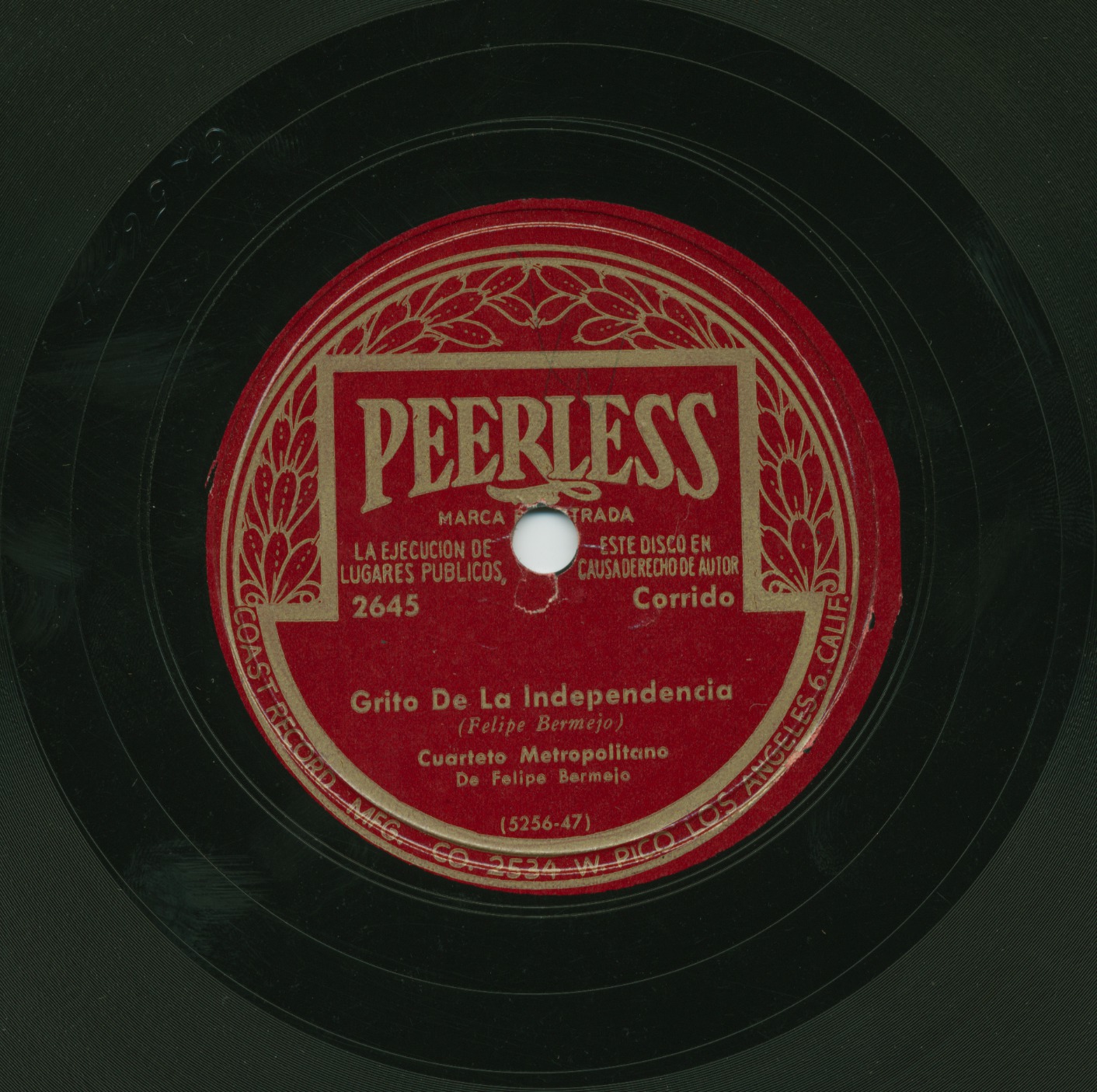El Grito: Music and Patriotism in Mexico
 There’s an old song in the Frontera Collection that captures the patriotic fervor surrounding the annual celebration of Mexican Independence Day on September 16. The first verse, however, includes a line that many Mexicans today would disagree with, considering the current climate of social unease.
There’s an old song in the Frontera Collection that captures the patriotic fervor surrounding the annual celebration of Mexican Independence Day on September 16. The first verse, however, includes a line that many Mexicans today would disagree with, considering the current climate of social unease.The song is titled “Grito De La Independencia,” referring the historic rallying cry for independence, which sparked the war against Spain in 1810. To this day, the Mexican celebration, on the eve of the actual Independence Day, involves a ritual recreation of the moment when Father Miguel Hidalgo rang the church bells in the town of Dolores, calling his countrymen to arms against colonial rule. This song, by Cuarteto Metropolitano de Felipe Bermejo on the historic Peerless label, echoes the traditional refrain, saluting the heroes of the struggle and ending with “¡Viva Mexico!”
Ya llegó el mes de septiembre.
¡Viva nuestra libertad!
Vamos al grito el día 15
Al palacio nacional.
A las 11 de la noche,
La campana original
Cantará como en Dolores
Con su voz tradicional
¡Vivan Hidalgo y Morelos!
¡Viva nuestra libertad!
¡Que viva México libre!
¡Viva el presidente actual!
That final line was obviously written for perpetuity. The composer, Felipe Bermejo Araujo, was perhaps hoping that future generations would simply fill in the blanks when they sang, “Long live the current president!” That’s where some modern-day Mexicans may take exception, as was recently demonstrated weeks ago when protestors called for a boycott of the Independence Day celebration in Mexico City that was to be led by the current mandatario, President Enrique Peña Nieto.
 Bermejo (1901-1989) was writing in a totally different era, one of rising nationalism after the Mexican Revolution of 1910. There is no date on the label of the 78-rpm recording of his “Grito.” But his biography suggests that it was probably written in the 1930s, when popular President Lázaro Cardenas consolidated the gains of the revolution and literally fueled national pride by expropriating the country’s oil industry. Mexican patriotism reached a peak during this period as political violence abated and the country could celebrate the success of a new society.
Bermejo (1901-1989) was writing in a totally different era, one of rising nationalism after the Mexican Revolution of 1910. There is no date on the label of the 78-rpm recording of his “Grito.” But his biography suggests that it was probably written in the 1930s, when popular President Lázaro Cardenas consolidated the gains of the revolution and literally fueled national pride by expropriating the country’s oil industry. Mexican patriotism reached a peak during this period as political violence abated and the country could celebrate the success of a new society.Bermejo himself was a child of the revolution. He was orphaned at an early age and helped support his six siblings by working as a chauffeur for the controversial revolutionary leader Venustiano Carranza, who is skewered satirically in some versions of the folk song “La Cucaracha.” Bermejo studied accounting but switched to the arts, in which he proved a versatile talent, writing poetry, playing guitar and even singing opera on the international stage, in Cuba and the United States. As a composer and performer of popular music, he had his biggest success in the 1930s with his own groups, first the Trio Acapulco followed by the Cuarteto Metropolitano. He would go on to write music for popular Mexican films, most famously El charro Negro (1940). And his songs would be recorded by the biggest names in the field, including Pedro Infante, Lucha Reyes, and Los Alegres de Terán. More recently, his festive “La Charreada” was recorded by Linda Ronstadt on her popular album Canciones de Mi Padre.
Bermejo is listed as sole composer on 124 recordings in the Frontera Collection, including some songs recorded by multiple artists. But he also penned many more numbers with co-authors, including some of his most popular ones, such as “El Corrido De Chihuahua,” with Pedro de Lille, and “Juan Colorado,” with Alfonso Esparza Oteo. His popularity earned him a place among 17 of the country’s top composers immortalized in busts in Mexico City’s Plaza de los Compositores.
Bermejo’s songs are brimming with that bravado and uplifting cheer of ranchera music, extolling the virtues of country life and celebrating Mexican folklore in all its colorful exuberance. So, his style is perfect for that patriotic spirit that lights up the country along with fireworks on the 16 de Septiembre.
This year in Mexico, however, the celebration was decidedly downbeat. The country has been besieged with a series of chronic maladies that have done much to depress nationalist fervor, from horrifying narco-violence to endemic corruption and disturbing events such as the disappearance of 43 students from Guerrero state, all feared dead as a result of suspected political violence.
The mood is so sour that President Peña Nieto cancelled the usual banquet held at the National Palace in advance of the official “grito” ceremony, marking the 205th anniversary of the country’s independence. The cancellation was called an austerity move, reflecting the growing sentiment that Mexico this year has nothing to celebrate. Critics, who blame Peña Nieto for the problems, called for a boycott of the traditional “grito” led by the president, which normally takes place before cheering citizens gathered at the Zócalo, the massive plaza outside the president’s palace.
Nevertheless, the plaza was packed and the celebration took place promptly at 11 p.m. on September 15, the eve of Independence Day. This news video gives a unique insider’s view of the event, showing the handsome president and his glamorous First Lady, a former actress, behind the scenes. They are seen walking down a hallway inside the palace to a large room where the president meets a military color guard for a brief ceremony. A soldier marches toward him and hands him the flag he is about to wave to the waiting throng below, which can be seen in the background through a window leading to the ceremonial balcony.
 The ceremony goes on without a hitch except for some protestors in the plaza, visible on other videos taken by the crowd. As is customary, musical entertainment preceded the official ceremony. This year, the top-billed act was Arrolladora Banda El Limón de René Camacho, one of the brassy, raucous bandas that have become popular recently. Still, the group has a long history, tracing its roots back 40 years to its namesake town of El Limón in the northern state of Sinaloa, the cradle of banda music. Although the band’s actual lineage is murky, the Frontera Collection has one interesting 78-rpm recording by a possible precursor of the group, Banda de Limón, Sinaloa. The recording, also on Peerless, features the upbeat tune “Los Papaquis” backed on the flip side by “Mazatlán,” a lilting bolero written by Gabriel Ruiz. The traditional, village-band style of this recording stands in contrast to modern-day bandas, which are louder and more aggressive.
The ceremony goes on without a hitch except for some protestors in the plaza, visible on other videos taken by the crowd. As is customary, musical entertainment preceded the official ceremony. This year, the top-billed act was Arrolladora Banda El Limón de René Camacho, one of the brassy, raucous bandas that have become popular recently. Still, the group has a long history, tracing its roots back 40 years to its namesake town of El Limón in the northern state of Sinaloa, the cradle of banda music. Although the band’s actual lineage is murky, the Frontera Collection has one interesting 78-rpm recording by a possible precursor of the group, Banda de Limón, Sinaloa. The recording, also on Peerless, features the upbeat tune “Los Papaquis” backed on the flip side by “Mazatlán,” a lilting bolero written by Gabriel Ruiz. The traditional, village-band style of this recording stands in contrast to modern-day bandas, which are louder and more aggressive. For its part, La Arrolladora didn’t downplay its patriotism this year, despite the protests. On the same day of their Zócalo performance, the group released a video of “Se Me Ve Lo Mexicano” (“It’s Easy to See That I’m Mexican”), a song that celebrates cultural identity with no apologies. The slickly produced video shows festive scenes of Mexico with couples dancing while the band sings the praises of the country, just like in the old days. A measure of the group’s success can be gleaned from its Facebook page, which shows more than 14 million “likes,” with 70,000 new ones added just last week. Not surprisingly, the new “likes” spiked on September 15 as the band took the stage for the capital’s “grito” celebration.
For its part, La Arrolladora didn’t downplay its patriotism this year, despite the protests. On the same day of their Zócalo performance, the group released a video of “Se Me Ve Lo Mexicano” (“It’s Easy to See That I’m Mexican”), a song that celebrates cultural identity with no apologies. The slickly produced video shows festive scenes of Mexico with couples dancing while the band sings the praises of the country, just like in the old days. A measure of the group’s success can be gleaned from its Facebook page, which shows more than 14 million “likes,” with 70,000 new ones added just last week. Not surprisingly, the new “likes” spiked on September 15 as the band took the stage for the capital’s “grito” celebration.Still, La Arrolladora did not entirely escape criticism by those dissatisfied with authority and angrily opposed to the current government. Commenting on a brief Facebook video posted by the band during its patriotic performance, one disillusioned fan expressed her displeasure with the band for participating in the official festivities. She vowed to never buy another one of their records ever again ̶ proving once again that in Mexico, music, and nationalism are inextricably aligned, for better or worse.
-Agustín Gurza
Tags
Images




